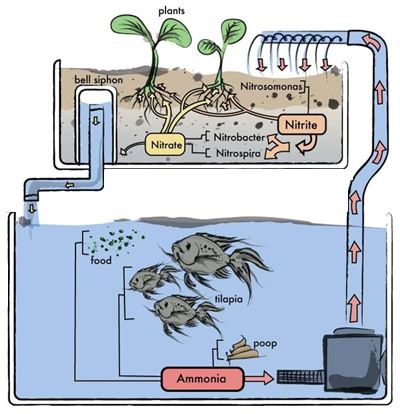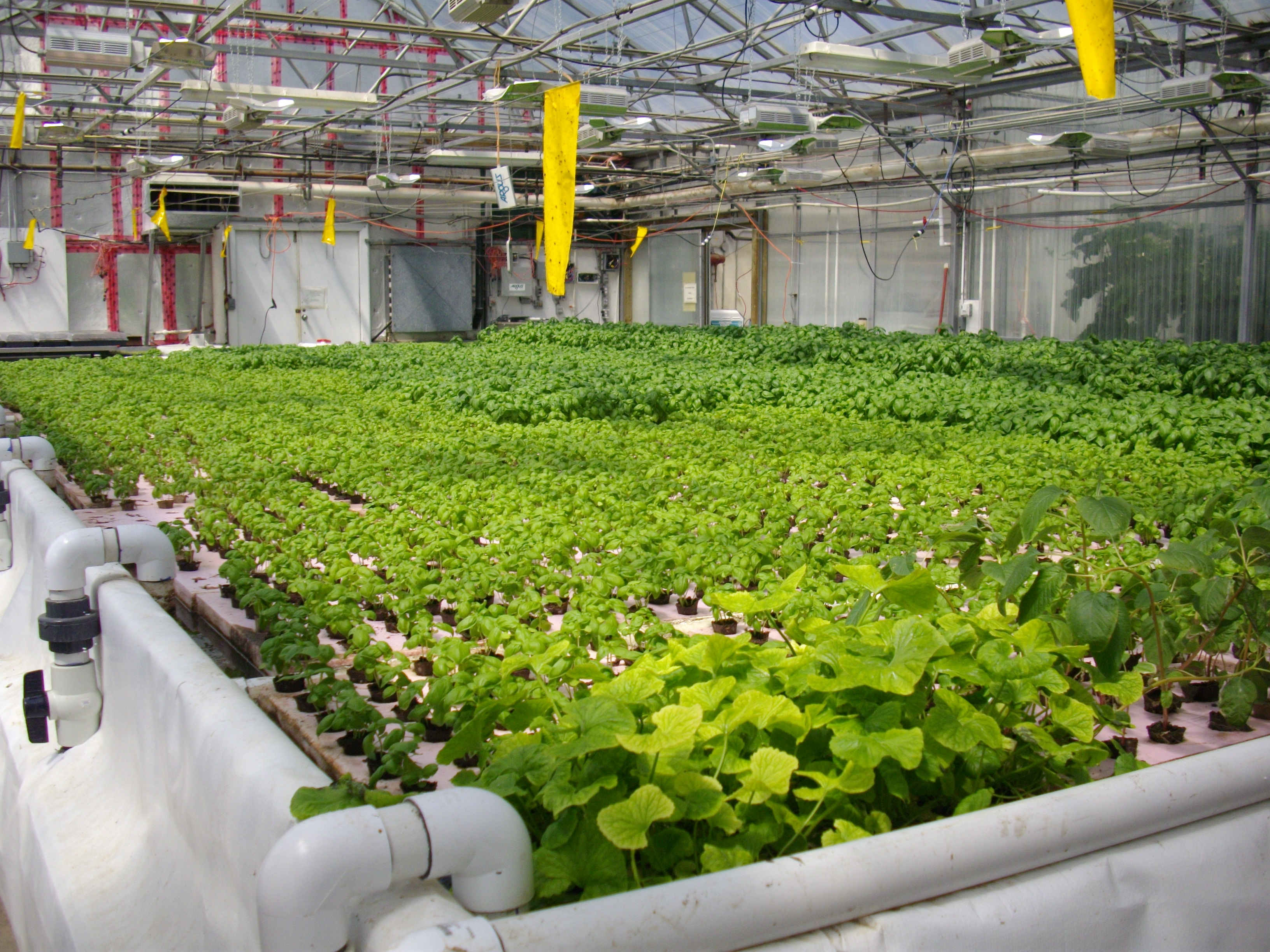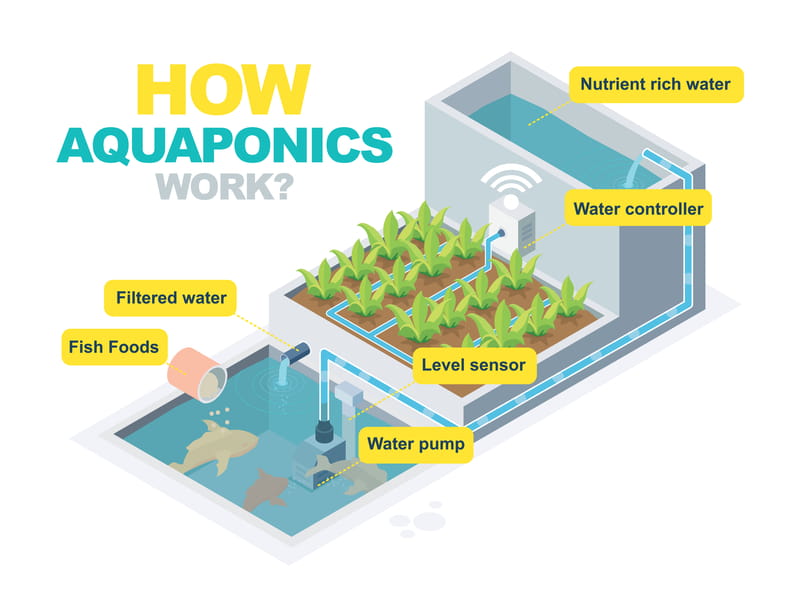
In order to make sure that the aquaponics system is functioning effectively, a variety of inputs are made continuously. Your aquaponic journey can profit greatly from automation of the aquaponic system.
An automatic fish feeder can be used to ensure that fish are fed on time in an aquaponic system, and a straightforward toilet float can be used to keep the water level consistent. Other parameters like crop health and water quality require manual maintenance.
You can choose the level of automation you want for your aquaponic system based on its size, your daily routine, and your financial situation.
See our comprehensive guide on aquaponics to learn all you need to manage a system successfully.
Even though it can appear difficult, automation is actually very easy if you have a small aquaponic system or are doing it for fun. Automation is easy to set up using a timer and float switch, but proper setup is essential to ensuring everything works as intended. Let’s now look at how to configure this automation.
Table of Contents
Build a successful system with this affordable equipment from Amazon, that I’ve tried & tested on my setup.
Search below on Amazon or your preferred vendor
| optimum water pump | Optimal Air Pump | Optimal Air Stones |
| cup plant nets | Bio-Filtration Medium | Kit to Test Water |
How to Automate an Aquaponic system?

Growing crops organically with aquaponics is a very sustainable method that can yield high-quality crops in a very little area. In some ways, aquaponics is automation in and of itself because the fish produce food for the plants, which then use the nutrients to avoid nutrient buildup that could harm the fish.
Up until the point of feeding the fish, it is an automated ecosystem created by the symbiotic link between plants and fish.
Now that we’ve reached a roadblock, an input is required. Routinely!
What if you could feed the fish without interfering too much? Perhaps your schedule prevents you from constantly watching the fish or making sure the water supply isn’t running low.
You could want to put up some form of automation now that your system is operational so you won’t have to keep checking the fish.
Setting up an automatic fish feeder is all that’s needed for the typical gardener with a small-scale system to feed the fish.
They simplify the process of determining how much and how frequently to feed your fish. They are particularly helpful for vacations and lengthy travel. Even when you are away, your fish will continue to receive regular food.
Depending on the size of the food you are feeding the fish, fish feeders are available in a wide range of forms and sizes. They function by setting a timer so that food can be fed to the fish dependent on the amount of time the timer keeps the feeder running.
The Eheim and Zacro automatic fish feeders from Amazon are the best feeders I could find that can accomplish this.
Given that it has two different power sources—a wired power outlet and a battery that can last between three and six months—the Zacro features are amazing. It can also be used as a fish stock in a fish tank that holds 600L (158 US gallons). The entire process is timed for your continence.
The Eheim can handle most types of fish food and has a ventilation system that always keeps your fish food dry so it doesn’t go bad. Both aquariums and smaller systems can use this feeder.
The Zacro would be my choice because it meets all of my demands for fish feeding.
Now, if you enjoy doing things yourself like I do—and you probably do, given that you want to improve your system. You may construct a fish feeder. It’s an easy project that you can complete using simple supplies.
Here is the one I created:
This homemade feeder includes
- holding the dry fish food container
- A bottom-mounted open pipe that allows food to be removed from the container and poured into the water
- a hardwire screw that is powered by a motor with a 5 rpm speed
- The motor is controlled remotely or at a predetermined time and is powered by a timer switch power outlet.
The water level in the system is another component that you ought to automate.
Aquaponic systems have water that is prone to evaporation. This indicates that the system’s water level is steadily decreasing. Because the evaporation process is gradual, you might not see it because it falls in small amounts.
The rate of evaporation may be higher on hotter days and depending on the climate, leading to an increase in water loss.
The roots of the plant mat grow long and large enough to eventually clog the exit pipes, which is another issue that could, but is not frequently, occur in aquaponic systems. A slow accumulation of material can also clog pipes over time.
Water is lost as a result of the overflow. The water loss can empty the entire system, depending on how your system is configured, and it can be very tiny or very substantial.
Using a tank float is a simple solution.
by floating the part that supports the water pump. It’s typically in the Sump. The water will always be at the same level. Consider the operation of the toilet tank. The float allows water to return to the tank after a flush without overflowing and creating a mess.
When you are away or unable to maintain your system, the straightforward float switch might prevent a lot of problems.
The third suggestion.
If the power goes out, I highly recommend investing in an automated backup electrical system. Aquaponic systems can be severely damaged by power outages.
These consist of:
- Pump stops functioning
- Fish feeder malfunctions
- Due to the pump failing, the water level rises and overflows into the sump.
- loss of oxygen and the air pump that keeps the fish alive
- Fish die as a result of the oxygen being depleted.
A 12 Volt battery is used in place of the standard 110 Volt power source by the backup power supply. This ensures that there are no negative repercussions on the system’s operation. Most power outages take no longer than a few hours, and a reliable backup source will enable smooth power transfer while providing enough running time.
You can also build a battery backup for the aquaponic system here. This one can serve as a blueprint for creating your own.
You can get a backup air supply in addition to a total power backup system to just keep your fish alive during the power outage. As long as they are in an NFT system, the plants will survive for this little duration.
Deepwater Culture systems are plants that can endure longer.
Pros and Cons of Automation

With these straightforward changes, automating an aquaponic system on a modest scale is undoubtedly feasible. But unless you choose to spend the money, this is the extent of it.
| Pros | Cons |
|---|---|
| minimal input upon installation | Expensive to Implement |
| timely fish feeding | Just a little more work to install it |
| The program can be used while traveling. | Automation could encourage complacency. |
| Stop water from evaporating. | |
| Protect crops from loss. | |
| Stop fish from dying. |
To achieve optimum crop quality, larger commercial systems that are also automated need some development.
even though it uses hydroponics. It demonstrates how far these systems can be automated.
FAQ
Can aquaponics be self-sustaining?
A self-sustaining system that may produce food is created by aquaponics, which blends hydroponics (the growing of plants in water) with aquaculture (fish, prawns, and snails). Nitrifying bacteria must be supplied to the fish’s water for the system to function.
Is aquaponics really profitable?
It is obvious that commercial aquaponics is not a guaranteed industry to be profitable, with only around 1/3 of farmers reporting that their operation is profitable.
How much do aquaponics farmers make?
Even the most prosperous aquaponics businesses, according to Timmons of Cornell, only make approximately $50,000 annually.
Are aquaponic farms profitable?
Aquaponic farms also have the benefit of being able to run year-round. All of this adds up to a system of food production that is much more profitable than ones based on soil.
Is aquaponics a good business?
Anywhere may use aquaponics to supply the rising demand for local, fresh produce and fish. Both profitable and sustainable, aquaponics. Without the use of artificial fertilizers, pesticides, or herbicides, crops are grown with less water and labor.
